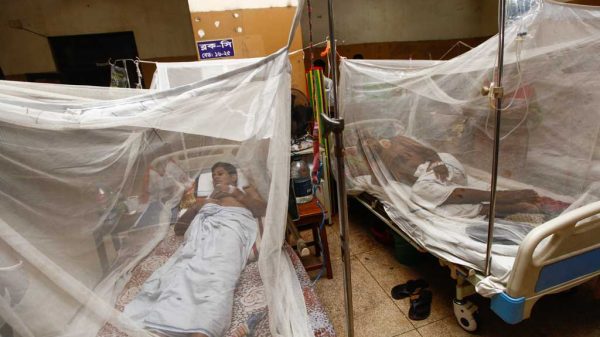Dengue may wreak havoc till October

Shawdesh Desk:
Experts see the potential for dengue fever to continue to wreak havoc in the country for at least another one and a half months until monsoon was over due to the current spell of intermittent rains and prevailing humid weather condition.
In Bangladesh, monsoon extends from June to September and government data show that dengue fever was mainly reported in these months since the fever was first detected in the country in 2000.
Monthly disaggregated data on dengue patients preserved by the government, however, were available only since 2014.
Data show that in three of the last five years, the month of September saw the highest number of patients seeking treatment for the mosquito-borne dengue fever.
‘It is not possible to single out a month as the dengue peak season,’ said Bangabandhu Sheikh Mujib Medical University virology professor SU Munshi.
‘Depending on weather conditions it can be any monsoon month that may be favourable for aedes mosquito to breed fast and spread the virus,’ he said.
August 7 of the current year saw the highest number of dengue patients — 2,428 in all — admitted to hospitals in a single day and there was a steady fall after that.
The lowest number of 1200 dengue patients was admitted to hospitals in a day this month on Tuesday, the last day of Eid vacation.
However, the number of dengue patients started to rise after Eid vacation was over. On Wednesday, 1880 dengue patients were admitted to hospitals.
On Thursday, 1929 dengue patients were admitted to different public and private hospitals.
SU Munshi said that aedes mosquitoes, which carry the virus causing the fever, breed comfortably in intermittent rains, high humidity and temperature.
Dhaka Medical College associate professor Robed Amin told New Age that the way it was raining over the last few days was favourable for fast breading of aedes.
He was apprehensive that dengue might continue to wreak havoc until the end of September.
Last year the highest number of 3,087 dengue patients was admitted in the month of September, according to Health Emergency Operation Centre and Control Room.
A total of 1,544 and 965 people fell sick with dengue fever in September in 2016 and 2015 respectively, said the health control room data.
In 2017, the highest number of dengue patients arrived at public and private hospitals in October. A total of 512 people contracted dengue that year.
In 2014, it was the month of July when 82 people sought treatment for dengue fever at public and private hospitals, the highest number of dengue patients that year.
Ayesha Akther, in-charge, Health Emergency Operation Centre and Control Room, told New Age that dengue outbreak was reported sooner this year because of weather conditions, which was favourable for aedes mosquito breeding, especially because of intermittent rains.
She said that the weather condition seemed to have been largely favourable for spread of dengue fever until now but hoped that public awareness would help contain it soon.
Robed Amin said that only awareness would not help the situation unless every section of the society was engaged in killing adult aedes mosquitoes and their larvae.
For instance, he said, the Philippines could control dengue epidemic only after it announced an emergency and called in the military to eliminate the dengue vector after the disease killed about 500 in six months.
‘The government must engage everyone effectively to eliminate aedes,’ said Robed.
In Bangladesh, the fever killed 104 people until Thursday, according to unofficial estimates, though the government put the number at 40.
On Thursday, four deaths caused by dengue were reported in Dhaka, Magura and Chandpur.
In Dhaka, a government health worker, Tapan Kumar Mandal, died of dengue at Bangladesh Medical College on Thursday afternoon.
Rony Akter, senior staff nurse at the hospital, confirmed that Tapan had been under intensive care for dengue fever since Wednesday.
The victim’s relative Sajal Mandal said that Tapan was transferred to Jurain from his immediate past workplace Madaripur to help treat the increasing number of dengue patients in the capital.
A garment worker, Mousumy Akter, 25, died of dengue at Dhaka Medical College and Hospital Thursday morning.
The victim’s husband Mohammad Mamun said that his wife was suffering from fever and cold for the last few days but was admitted to hospital on Wednesday after her condition deteriorated.
New Age correspondent in Magura reported that a man named Joynal Sharif died of dengue Thursday.
Joynal, a security guard, returned home on August 7 after being diagnosed with dengue fever.
He died apparently from lack of treatment as his family members kept him at home despite repeated advises from physicians to have him admitted to a hospital for better treatment.
In Chandpur, Abu Bakar Shihab, 14, died of dengue on Wednesday evening, reported United News of Bangladesh.
Since January, 48,280 people have been hospitalised with dengue fever and 40,670 were released after treatment, according to Health Emergency Operation Centre and Control Room.
At the moment, the number of dengue patients being treated at government and other hospitals in outlying districts stood at 7,570, said the control room.
Since dengue’s first occurrence in Bangladesh in 2000, the infected patients over the years have mostly been confined to the capital city. But this year is an exception — the mosquito-borne viral fever has spread all over the country for the first time.























Leave a Reply